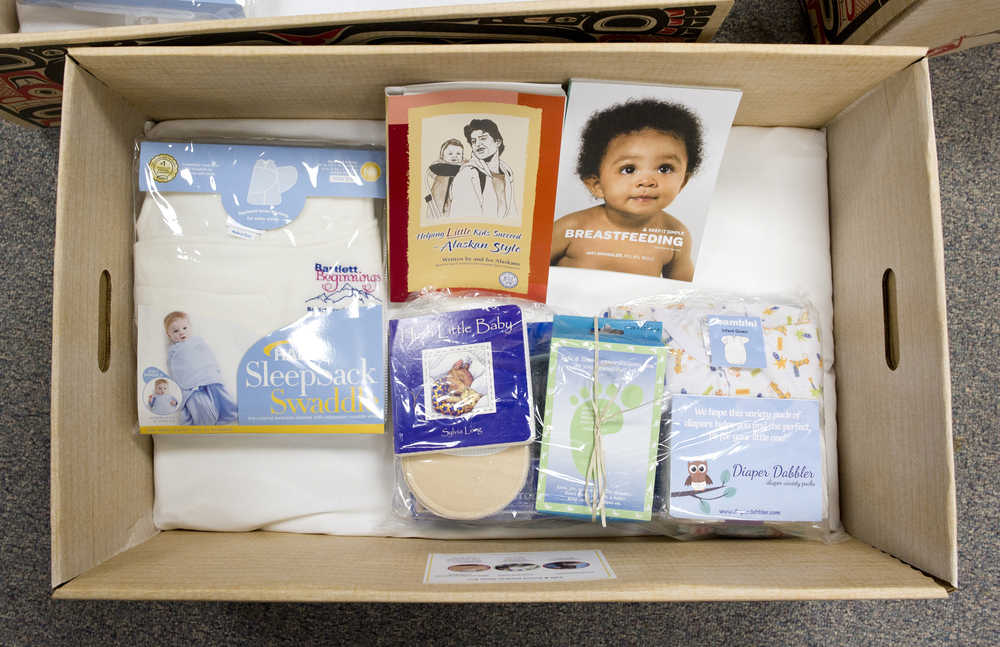On a sunny Wednesday morning at Bartlett Beginnings Family Birth Center, new mom Kaity Conrad set down her 10-day-old daughter Amelia into what looked like a giant shoebox.
The box, covered in an intricate Alaska Native design, is one of the hundreds of baby boxes Bartlett Regional Hospital Foundation is supplying mothers who give birth at the hospital.
“She loves it,” Conrad said as she watched Amelia stretch and yawn while lying on the firm, white mattress inside the bassinet-functioning box. She said she uses it for her daughter frequently at home.
Karen White, director of Bartlett Beginnings, and Maria Uchytil, executive director of Bartlett Regional Hospital Foundation displayed the baby box contents on a nearby table: onesies, a blanket and first-aid kit, educational material and other useful items mothers need for the beginning of their child’s life.
“I use the wash cloth, the sleep set, the breast thing,” Conrad said, referring to the breast shawl, “the little nail clippers out of the grooming kit, and that’s all so far. But I’m sure I’ll use more of it. It’s only been a week,” she said with a laugh. “I think it’s all pretty helpful in there.”
[One stop for young families: 2nd annual baby fair]
BRHF began giving out baby boxes to new mothers at the beginning of this year. It doesn’t matter if it’s the mother’s first baby or fifth, or if she’s well-off or not, all new mothers are given the box, free of charge.
The box is more than just a nice gesture — the idea behind it is actually to help combat sudden infant death syndrome (SIDS), White and Uchytil said. SIDS is when a baby dies in his or her sleep either from physical factors (brain abnormalities, low birth weight, respiratory infection) or sleep environment factors (sleeping on the stomach or side instead of their back, sleeping on a soft surface and sleeping with parents which may include soft surfaces which could impair breathing and lead to suffocation).
White explained that the baby boxes address the sleep environment factors. In a baby box, parents have a portable place for their baby to sleep safely. The mattress is firm so the baby doesn’t sink into the softness, and there is nothing that the baby can roll into that could block his or her airway.
“We have information on how to use the box, basically, and some precautions how not to use the box,” White said, adding that each box comes with instructions.
The first so-called baby boxes were developed in Finland to combat a high infant mortality rate after World War Two. Finland launched multiple approaches to combat the deaths, such as furthering prenatal care, and the mortality rate dropped precipitously.
Finland’s baby box program is still ongoing, but now it’s made its way to the U.S., even Alaska. Both PeaceHealth Medical Center in Ketchikan and Providence Alaska Medical Center in Anchorage have baby box programs. Ketchikan’s boxes feature the same Alaska Native design as the Juneau boxes, by artist Ken Decker.
According to the Alaska Department of Health and Social Services Division of Public Health in 2012, infant mortality was 5.18 per 1,000 live births in Alaska. To combat infant mortality, the Division of Public Health launched the Alaska Infant Safe Sleep Project. The project partnered with birthing facilities in Alaska to promote consistent and evidence-based infant safe sleep messages and practices.
“There was a team of us working on that policy based on the state’s recommendations and guidelines and we did staff training,” White said about the project’s origins. “One of the team members found baby boxes when she was doing some research. She was very passionate about it and went and talked to our grant writer and Maria [Uchytil].”
Soon the Bartlett baby boxes were born. The team found a company to make the boxes and BRHF raised the money to make it happen. BRHF ordered 400 boxes for babies based off of the number of expected births in 2016 (about 400 babies were in born in Juneau in 2015), Uchytil said. They spent about $40,000 for all the boxes, Uchytil said, and that includes the shipping; it comes out to be about $100 per box. BRHF keeps a couple dozen boxes on hand at the hospital, and the rest are being held in donated space from GCI and World Wide Movers where they wait to be assembled when needed.
Uchytil said about every six weeks a group of volunteers assemble boxes to have at the ready at the hospital. As long as they can fundraise enough money for the boxes, they want to keep supplying them to the community.
• Contact Clara Miller at 523-2243 or at clara.miller@juneauempire.com.

